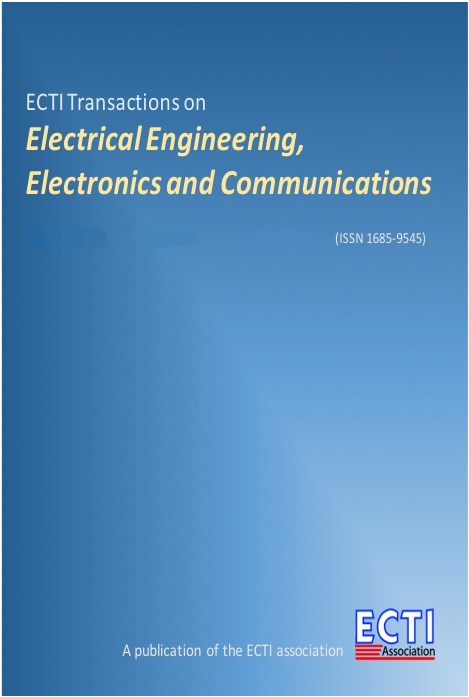Synthetic Domestic Electricity Demand in Thailand using A Modified High Resolution Modelling Tool by CREST
Main Article Content
Abstract
A residential electricity demand profile is one of the key roles for investigating the impacts of high penetration of low carbon technologies, such as photovoltaic systems and electric vehicles, on distribution networks. However, it is difficult to identify the true daily electricity consumption of Thailand household, caused by the lack of routine real time demand monitoring and residential electricity meter is normally on monthly which is a low time resolution. In this paper, the CREST Demand Model is employed to simulate a high resolution domestic electricity demand in Thailand, without installing new monitoring devices and customer interruption, through a stochastic process which is a combination of patterns of active occupancy, the outdoor ambient light characteristic and daily activity profiles. Due to the model is based on time use survey data in UK, the outdoor irradiance and appliance configuration are adapted to fit for the Thailand case study. In order to verify the model, the synthetic load profiles by CREST Demand Model is compared against measured data from the actual monitoring in a real low voltage network in Thailand. The results show that it is promising to apply the high resolution demand model by CREST to simulate the domestic electricity demand profiles in Thailand.
Article Details
This journal provides immediate open access to its content on the principle that making research freely available to the public supports a greater global exchange of knowledge.
- Creative Commons Copyright License
The journal allows readers to download and share all published articles as long as they properly cite such articles; however, they cannot change them or use them commercially. This is classified as CC BY-NC-ND for the creative commons license.
- Retention of Copyright and Publishing Rights
The journal allows the authors of the published articles to hold copyrights and publishing rights without restrictions.
References
[2] J. Torriti, “A review of time use models of residential electricity demand,” Renewable and Sustainable Energy Reviews, Vol. 37, pp. 265-272, 2014
[3] M. Stokes, M, Rylatt, M. and K. Lomas, “A simple model of domestic lighting demand,” Energy and Buildings, Vol. 36, No. 2, pp. 103-116, 2004.
[4] U. Wilke, F. Haldi, J.L. Scartezzini and D. Robinson, “A bottom-up stochastic model to predict building occupants' time-dependent activities,” Building and Environment, Vol. 60, pp. 254-264, 2013.
[5] J. Widén and E. Wäckelgård, “A high-resolution stochastic model of domestic activity patterns and electricity demand,” Applied Energy, Vol. 87, No. 6, pp. 1880-1892, 2010.
[6] I. Richardson, M. Thomson and D. Infield, “A high-resolution domestic building occupancy model for energy demand simulations,” Energy and Buildings, Vol. 40, No. 8, pp. 1560-1566, 2008.
[7] I. Richardson, M. Thomson, D. Infield and C. Clifford, “Domestic electricity use: A high-resolution energy demand model,” Energy and Buildings, Vol. 42, No. 10, pp. 1878-1887, 2010.
[8] E. McKenna and M. Thomson, “High-resolution stochastic integrated thermal–electrical domestic demand model,” Applied Energy, Vol. 165, pp. 445-461, 2016.
[9] Centre for Renewable Energy Systems Technology, “CREST Demand Model,” Loughborough University UK. [Online], Available: https://www.lboro.ac.uk/research/crest/demand-model. [Accessed: Jul, 25, 2019].
[10] V. Powell, “Markov Chains: A visual explanation,” Jul. 26, 2014. [Online], Available: http://setosa.io/blog/2014/07/26/markov-chains. [Accessed: May, 2, 2019].
[11] I. Richardson, M. Thomson, D. Infield and A. Delahunty, “Domestic lighting: A high-resolution energy demand model,” Energy and Buildings, Vol. 41, No. 7, pp. 781-789, 2009.
[12] Ipsos-RSL Ltd, United Kingdom Time Use Survey, 2000. 3rd ed., Office for National Statistics, Colchester, Essex, UK, 2003.
[13] R. Punyachai, W. Ongsakul and U. Schmidt, “Impact of high solar rooftop PV penetration on voltage profiles in distribution systems,” in International Conference and Utility Exhibition on Green Energy for Sustainable Development, Pattaya, pp. 1-7, 2014
[14] Population Statistics Group. Preliminary Report The 2010 Population and Housing census (Whole Kingdom). National Statistical Office of Thailand. 2010.
[15] Department of Statistics Online Programs, “The Coefficient of Determination, r-squared.” The Pennsylvania State University. [Online], Available: https://onlinecourses.science.psu.edu/stat501. [Accessed: May, 2, 2019].


